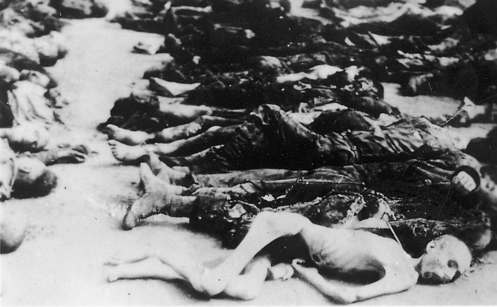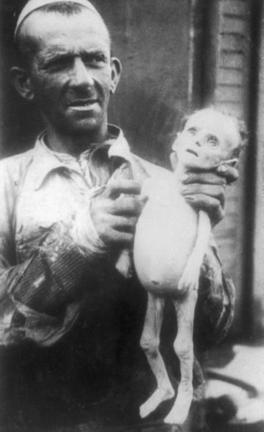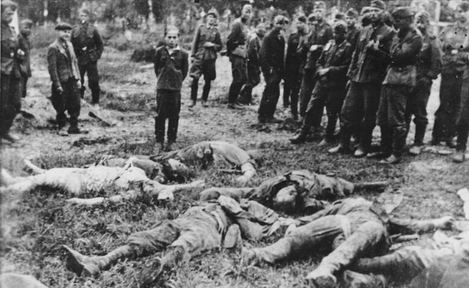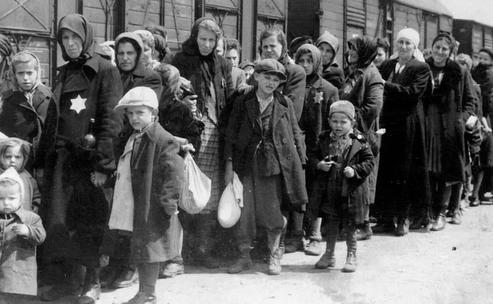
Deceased found at the Buchenwald camp.
My aunt, Chaya Turkeltaub, had hidden out of fear of a forthcoming Aktion against Jews. Her hideout was a Polish farm in the village of Zabikow, about 6 kilometers from Radzyn. I do not know whether it happened by accident or during a search, but she was found, recognized as a Jew, and shot immediately. The Gendarmeri continued its search in other houses where they discovered another two older Jewish women, Mrs. Gelibter and Mrs. Steinberg, who they also shot. When we received news of the tragic events, my cousin Mendl Turkeltaub and relatives of the other murdered women hired a Polish driver with a horse-drawn wagon and proceeded to the village to retrieve the corpses and bury them at the Jewish cemetery in Radzyn. The same Gendarme stopped the wagon when it approached the village, asked the three passengers what they wanted and then, having identified them as Jews, shot them.
THE DEAD YEARS
By Joseph Schupack
“So much happened in Auschwitz. I remember a mother and daughter who lived together in the same barracks. They were from Lodz. When they came to take the mother away, when she did not pass a selection, her daughter grabbed on to her and would not let go. I saw them pulled apart by the soldiers who came for the mother. As the mother was led away the daughter had to be held down. They called each other’s name over and over. All of us who watched couldn’t help but cry.”
THE BLEEDING SKY: MY MOTHER’S JOURNEY THROUGH THE FIRE
By Louis Brandsdorfer
“I proceeded on Sunday morning with most of my comrades to the Jewish cemetery [Schwetz, Poland]… We saw then how a group of a woman and three children, the children aged about three to 8 years, were led from the bus to a shoveled out grave of about 8 meters width and 8 meters length. The woman had to climb into this grave and took her youngest child on her arm. Both other children were passed to her by two men of the execution Kommando. The woman had to lay on her stomach flat in the grave, that is with the face to the earth, her three children lined up on the left in the same way. Then 4 men similarly climbed into the grave, pointed their guns so that the muzzle was about 30 cm. from the back of the neck, and shot in this way the women with her three children.”
SOURCES OF THE HOLOCAUST
By Steve Hochstadt
On May 16 the first three trains from Hungary arrived, and the biggest campaign of extermination began… “On some days the arrivals were simply wild,” wrote Oswald Kaduk. “Five transports had already arrived by half past ten one morning.” As had been done in the early period of the camp, the corpses were burned on pyres that were set up in the open air next to the crematoriums, for the capacity of the ovens was insufficient.
PEOPLE IN AUSCHWITZ
By Hermann Langbein
The fourth Novogrodek massacre took place on 7 May 1943. Two hundred of the 500 Jews living in the Arbeitslager (labor camp) were killed. Most of these were women. The killing was done near the forest of Horodzhilovka, quite close to the camp. Those remaining in the camp could hear their loved ones being butchered with machine-guns. My dear aunt Dvore (my cousin Idel’s mother), my aunt Haike Sucharski and my cousin Nachama, Idel’s sister, were murdered that day.
SURVIVING THE HOLOCAUST WITH THE RUSSIAN JEWISH PARTISANS
By Jack Kagan and Dov Cohen
“Can a person understand what it means to have a cold without a handkerchief or diarrhea without a piece of paper?”
PEOPLE IN AUSCHWITZ
By Hermann Langbein
“Their first task [at the gas chamber] was to remove the blood and defecations before dragging the clawing dead apart with nooses and hooks, the prelude to the ghastly search for gold and the removal of teeth and hair which were regarded by the Germans as strategic materials. Then the journey by lift or rail-wagon to the furnaces, the mill that ground the clinker to fine ash, and the truck that scattered the ashes in the stream of the Sola.”
CHRONICLES OF THE HOLOCAUST
By Roselle K. Chartock and Jack Spencer
Celie, Rosie and I filled the women’s tin cups with water. Most were grateful to us, but some had become delirious, calling for their mothers to help. Who knew if their mothers were still alive? Others were very quiet, not talking at all, eyes staring at nothing. Every morning, one or two of the women were no longer there, having died in the night. It seemed like it was always the quiet ones who died. Their bunks were quickly filled by others. One day, a woman from Budapest, about twenty-five years old started ranting about food, about her family, about the war. She somehow got to the top of the roof and simply jumped off.
I CARRIED THEM WITH ME
By Sara Lumer
We cried and held each other. There was nothing else said. We had known that this day would eventually come and now it was here. We could hear the heavy footsteps of the soldiers in our building, the bangs of the rifle butts hitting the doors and harsh commands uttered in that guttural language. Then, the knock on our door. “Get out, Jews! We will give you ten minutes!” How generous of them. We stood there, our family, Papa, Mama, Jacob, only six years old, Stanley, thirteen, and myself, just fourteen, with our arms around each other. Our tears were flowing uncontrollably. We kissed each other goodbye for we knew there was little chance of our family remaining together.
OUTCRY: HOLOCAUST MEMOIRS
By Manny Steinberg
Efraim Stiebelmann once observed the following event: “A transport from Lodz arrived, and Mengele chose those who would work and those who were to be gassed. A woman with a daughter aged thirteen or fourteen did not want to be separated from her. Mengele ordered a guard to take the girl away from her by force, whereupon the woman attacked the guard, hit him, and scratched his face. Mengele drew his pistol and shot mother and child. I saw this clearly.”
PEOPLE IN AUSCHWITZ
By Hermann Langbein
As my mother and I walked in [at Auschwitz], hands clasped tightly together as if we were a life line for each other, there were men dressed in stripes everywhere. Together with those who had travelled with us, we stood in a line, confused, hungry and exhausted. One of the Germans who was dressed in uniform was putting us into groups. He took one look at me and then at my mother, and immediately separated us. I screamed, shouted, I begged but it was no use. The last member of my family was taken away from me, and I was powerless to stop it. I never saw my mother again.
HOLOCAUST: A JEWISH SURVIVOR TESTIMONY
As Told by Regina Weinkrantz
Edited by Dan Myers

Corpse of a starved Jewish infant. Warsaw Ghetto, Poland, 1942.
One rainy night he [non-commissioned officer] and another soldier arrived at our door, pistols in hand. I wasn’t home. He put his gun against my mother’s head and demanded, “Where’s your daughter?” “I don’t know,” she replied and told them to search the house if they didn’t believe her. His pal slapped her, threw her against the stove, and beat her with the broom handle while Gottschalk stood there egging him on. “He’s from Vienna, a backwater town. Beating is second nature to him,” Gottschalk said. “I myself am from Berlin.” Not finding me at home, Gottschalk and his henchman left and went looking for me at the home of one of my aunts. When I wasn’t there either, they raped my aunt and forced her husband to watch. The rape had to be kept secret because, had the Gestapo found out, they would have killed her immediately: Germans were forbidden to “fraternize” with “subhuman” Jews.
LOVE IN A WORLD OF SORROW
By Fanya Gottesfeld Heller
“I go with Ernst to the cellar, where the majority of new arrivals were housed. A capo is talking to them, and we listen. He asks them about Hungary, how things look on the outside. Then a Hungarian asks: ‘Can you tell me where my parents and my wife are? I said farewell to them on our arrival, and they were put on a truck. A gentleman from the SS said older men and women should get on the trucks so they don’t have to walk so far. But I haven’t been able to see them here yet.’ ‘You jackass, you’ll never see them again. Your wife has been singing hallelujahs for quite a while now, and your parents are coughing; you see, they swallowed a bit too much gas.’”
PEOPLE IN AUSCHWITZ
By Hermann Langbein
From my “observation post” I watched as the “Black Police” whipped columns of women and children along Tankova Street. The screams of the terror-stricken women and children rose to the heavens and chilled the blood…Suddenly I heard shooting inside the hospital itself. Not until later that evening did I learn that the killers – for the first time – had invaded the hospital. Still avoiding the Contagious Diseases Ward, they went straight to the surgical floor, shot the patients and all the medical personnel.
THE MINSK GHETTO
By Hersh Smolar
“We lived in Poland, in the ghetto of Lvov. My father was always looking for places to hide my little brother, Pavel, and me because the Germans were intent on getting rid of all the Jewish Children. One hiding place was a small, empty space, three feet long and one foot deep, below the window, which my father had camouflaged to look like the wall. I remember having to sit there with Pavel for hours, struggling for air and being so scared! Tears were running down my cheeks, but I didn’t dare make a sound for fear the Germans would find us. But silently I prayed for my father to come and let us out. Each time he came back, I begged him, ‘Daddy, please let this be the last time.’ I didn’t think I could take it anymore.”
THE HIDDEN CHILDREN
By Jane Marks
With the temperatures hovering far below zero, the Jews [of Novogrudok] were then directed to remove their clothing and stand facing two forty-by-three-meter graves that had been dug days before. The shooters then machine-gunned them to death. The action was repeated throughout the day, as trucks returned to the courthouse to pick up additional victims. As the sun set on the black Monday, more than four thousand Jews had been murdered. Among those lying dead in the ditches were David and Beyle Bielski, Cila Bielski, and her baby
girl. [The Bielskis were famous Jewish Partisans.]
THE BIELSKI BROTHERS
By Peter Duffy
We know about Svidersky, a one-eyed German from Odessa who was known as “Master Hammer” [at Treblinka] because of his supreme expertise in “cold murder” – that is, killing without firearms. It took him only a few minutes – with no weapon but a hammer – to kill fifteen children, aged eight to thirteen, who had been declared unfit for work.
THE HELL OF TREBLINKA
By Vasily Grossman
Five more SS officers and doctors came in [at Ravensbrück]… Helena Piasecka was particularly badly mutilated; a liquid had been injected into the bone marrow so that the leg looked as if it was crumbling. When Helena tried to walk on it some weeks later, the shin bone shattered.
RAVENSBRÜCK
By Sarah Helm
The Germans were still pouring more Jews into our city [Międzyrzec, Poland]… we saw more and more people going door to door begging for food. We knew people slept on the floors… with no food, running water, or heat. We knew people in these buildings were shivering, covering up their faces and heads with only the clothes they had with them for warmth. Many died. There was no heat in those buildings, and the corpses were cast out in front of the doorway, mostly children and old people, hundreds of them. The grave diggers had a small, two-wheeled pushcart on which they loaded eight or ten corpses and took them to the graveyard to be dumped in mass graves. Then they’d go back for more. Most of the corpses were frozen solid… Over and over again, I saw the mass graves, the piles of arms and legs and death-grinning heads, their eyes open in a kind of wide-eyed amazement that they had died such a terrible death. Dead from starvation or freezing to death.
DEFY THE DARKNESS
By Joe Rosenblum with David Kohn
Abraham Goldfarb testified about a Treblinka transport in which most of the passengers died en route: “At the end of August 1942, the Germans carried out the expulsion from Mazaritz…When the Jews were brought to the railway station, the Germans forced 150-200 of them into a freight car designed for sixty or seventy. The cars were closed from the outside with boards. Water and food were not provided. People were suffocating; there was no air to breathe. Before we moved off, the Germans sprinkled chlorine in the cars. It burned the eyes. The weaker among us fainted. People climbed on top of each other and banged on the walls with whatever they could find. The children were so thirsty they licked their mothers’ sweat…There were 150 people in our freight car. During the two-day trip to Treblinka, 135 suffocated.”
BELZEC, SOBIBOR, TREBLINKA
By Yitzhak Arad
“We said good-bye to our families as about one hundred SS with machine guns marched out 250 men. In stalls normally housing horses, a man asked about our wives. The SS commander said, ‘I’ll tell you about your wife.’ He took out his gun and shot him.”
OUR CRIME WAS BEING JEWISH
By Anthony S. Pitch
During evening roll call in Buchenwald on December 14, 1938, two prisoners were missing. The temperature was thirty-six degrees, but the thinly clad inmates had to stand in the roll-call area for nineteen hours. By the next morning, twenty-five had frozen to death, by noon the number had reached more than seventy.
PERPETRATORS
By Guenter Lewy

A teenage boy standing beside his murdered family shortly before his death by the SS. Ukraine, 5th of July, 1941.
Romanian forces occupied Odessa, on the Black sea due south of Kiev, on 16 October 1941… On 23 October 1941… some ten thousand Jews were marched outside town the same day and murdered with machine guns. Two days later several thousand more were locked into a large barn, which was then blown up with dynamite… “No matter in which direction you looked [in Odessa] you could see gallows. There were thousands of them. At the feet of the hanged lay the bodies of those who had been tortured, mutilated and shot… “Across the Black Sea on the Crimean Peninsula mass murder took a more inventive form. In the course of the war in the Crimea, according to the indictment of the International Military Tribunal at Nuremberg, “144,000 peaceful citizens were gathered on barges, taken out to sea and drowned.”
MASTERS OF DEATH
By Richard Rhodes
In 1941, when the Germans killed all the Jews in Fastov, they left the children. There were about eight hundred of them. They gave the order that every villager had to take one child each and feed it along with bring it up well. And if so much as one child were to die, then the whole family would answer for it. They fed these children for three months. When that period of time was up, when the children were in better health, the Germans gave the following order: “All the children of the Jews are to be returned to a designated place. Refusal will mean death.” The children were brought, then taken to a hospital. There they were tied down to beds and their blood sucked out for wounded Germans. And the fate of the children was sealed.
THE UNKNOWN BLACK BOOK
By Joshua Rubenstein and Ilya Altman
“I remember there was a really young French girl, maybe 15 or 16 years old. She didn’t understand a word of German. The SS women always gave their commands in German. This girl naturally didn’t understand and was beaten terribly. The girl yowled like a beaten dog. I can still hear her today.”
VOICES FROM THE THIRD REICH
Steinhoff, Pechel and Showalter
Another scene saw some of the Germans in this battalion compel old Jewish men to dance before them. In addition to the amusement that they evidently derived from their choreography, the Germans were mocking, denigrating and asserting their mastery over these Jews, particularly since the selected Jews were their elders, people of an age to whom normally regard and respect are due. Apparently, and to their great misfortune, the Jews failed to dance to a sufficiently brisk and pleasing tempo, so the Germans set the Jews’ beards on fire.
HITLER’S WILLING EXECUTIONERS
By Daniel Jonah Goldhagen
During the war the SS separated thousands of children from their parents and sent them to Buchenwald. The first group arrived as early as 1939. Most were Jewish children or the children of executed partisans. In the fall of 1944 the SS suddenly herded together all the Jewish and Gypsy youngsters and shipped the “screaming, sobbing children” to the Auschwitz gas chambers.
HITLER’S DEATH CAMPS
By Konnilyn G. Feig
Between 1933 and the outbreak of war in September 1939, approximately half of the Jews in Germany – some three hundred thousand people – left. Much of this exodus took place in the wake of Kristallnacht from what had been Austria and the Sudetenland as well as from all over Germany. For most European Jews it took enormous perseverance and ingenuity to get out, to find somewhere to go, and to figure out ways to start new lives.
THE HOLOCAUST: A CONCISE HISTORY
By Doris L. Bergen
The earliest large-scale massacre of Romanian Jews took place in Iasi, the capital of Moldavia. After thousands had been massacred in the city, several thousand more were packed into the hermetically closed cars of two freight trains and sent on an aimless journey lasting several days. In the first train 1,400 Jews suffocated or died of thirst; 1,194 bodies were recovered from the second one. The exact number of the victims of the Iasi program remains in dispute, but it may have exceeded ten thousand.
NAZI GERMANY AND THE JEWS 1933-1945
By Saul Friedlander
About ninety children were packed together into two small rooms… in a filthy state [in Belajar Kharkov, Ukraine]. The children lay or sat on the floor which was covered in their feces. There were flies on the legs and abdomens of most of the children, some of whom were only half dressed. Some of the bigger children (two, three, four years old) were scratching the mortar from the wall and eating it. Two men, who looked like Jews, were trying to clean the rooms. The stench was terrible. The small children, especially those who were only a few months old, were crying and whimpering continuously…Groscurth asked the man what would happen to the children. “He informed me that the children’s relatives had been shot and the children were also to be eliminated.”
MASTERS OF DEATH
By Richard Rhodes
When the killing was finally ready to commence [at Lomazy, Poland], the men of Second Platoon formed a gauntlet running between the staging ground for the killing and the killing site itself. Successive groups of fifteen to twenty Jews were forced to run to the killing site’s pit to run the German gauntlet, with the Germans shouting at them and beating them with rifle butts as they passed by. As if this general terrorizing and torturing of the victims during their final moments of life were not satisfying enough, Gnade selected Jews of heightened symbolic value for special treatment.
“During these executions I observed still something else which I will never forget. Even before the executions began. Lieutenant Gnade himself had selected about twenty to twenty-five elderly Jews. They were exclusively men with full beards. Gnade made these old men crawl on the ground before the grave. Before he gave them the command to crawl, they had to undress. While the now completely naked Jews were crawling, lieutenant Gnade screamed to those around, ‘Where are my NCOs, don’t you yet have any clubs?’ Thereupon the NCOs went to the edge of the forest, got themselves clubs, and then with these clubs rained mighty blows on the Jews…it is my opinion that all of the NCOs of our company complied with the Lieutenant Gnade’s order and rained blows on the Jews…”
HITLER’S WILLING EXECUTIONERS
By Daniel Jonah Goldhagen

Hungarian Jews lining up for the selection at Auschwitz. Most would be dead within hours.
